Cycle News Staff | March 30, 2017
2017 Yamaha WR450F vs. Suzuki RMX450Z vs. Honda CRF450X: SHOOTOUT
We compare the three 450cc California Green Sticker off-roaders from Japan.
If you live and ride outside California, especially the southern half of California, the OHV Green Sticker doesn’t affect your life much, but for those who live and ride on public lands in California, it’s kind of a big deal if you like to ride a lot—year-round a lot. That’s because there is a period of the year (basically the hot months of June through September) when the bike you ride must meet Green Sticker regulations.
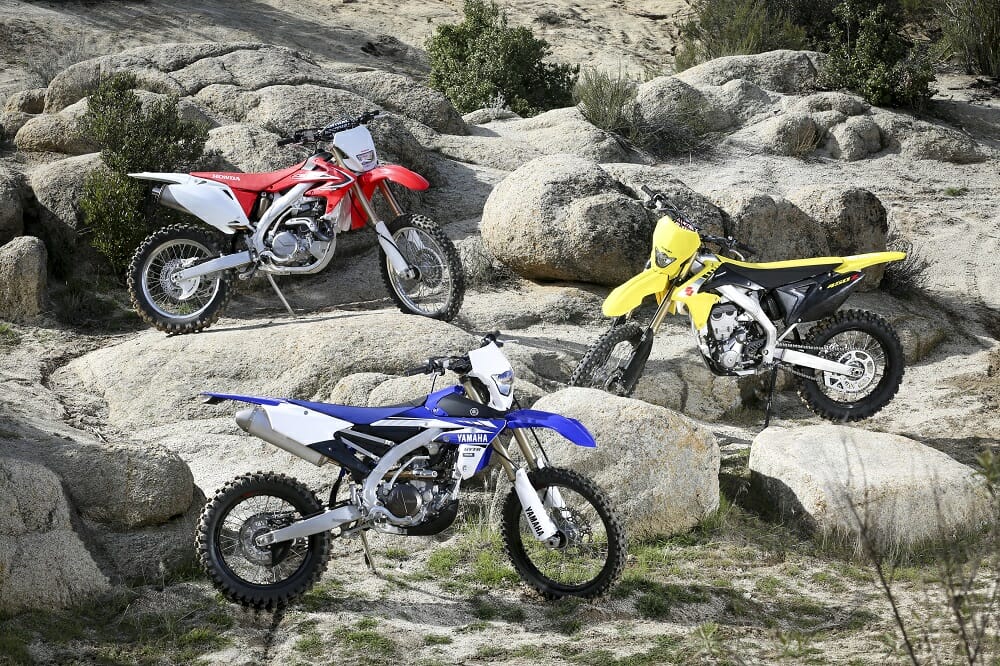
California Green Sticker-legal vehicles are subjected to evaporative, exhaust and sound emission requirements set forth by the EPA and face more stringent regulations than Red Sticker bikes. Modifying, tweaking or changing anything related to the engine and exhaust on a Green Sticker bike instantly turns it into a Red Sticker bike. Again, for most of the country this isn’t even an issue, since most Southern Californian riders don’t mind not riding in 100-degree heat and dust anyway.
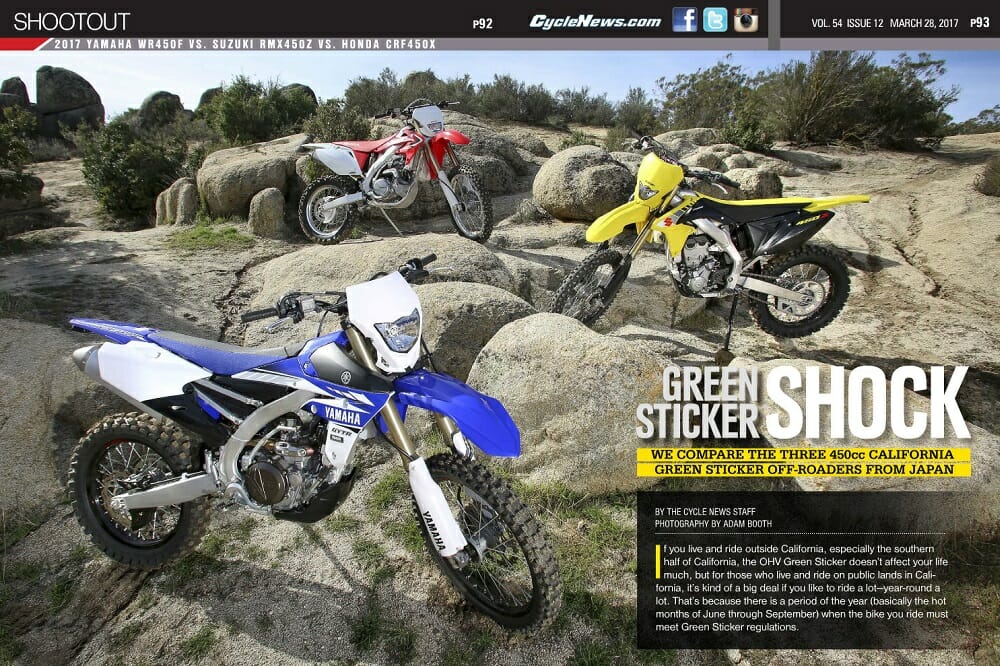
Click here to read this in the Cycle News Digital Edition Magazine.
PHOTOGRAPHY BY ADAM BOOTH
Still, there are those who do, and the Honda CRF450X, the new Suzuki RMZ450Z and the Yamaha WR450F are all designed for them. These are the only 450-class four-stroke Green Sticker-complaint trail bikes offered by the Big Four manufacturers from Japan. Some of the European manufactures, like KTM and Husqvarna, don’t even bother offering Green Stickers bikes anymore, instead having chosen to go the extra distance—which really wasn’t all that far—to take their Green Stickie bikes and just make them street legal.
Whatcha Got?
Even though these three bikes are similar in design in that they all have 449cc single-cylinder Green Sticker-compliant four-stroke engines, aluminum frames, electric starting, head and tail lights, five-speed wide-ratio transmissions, kickstands, 18-inch rear wheels, coil-spring forks, spark arresters and are designated for the trails, they each have their own unique story.
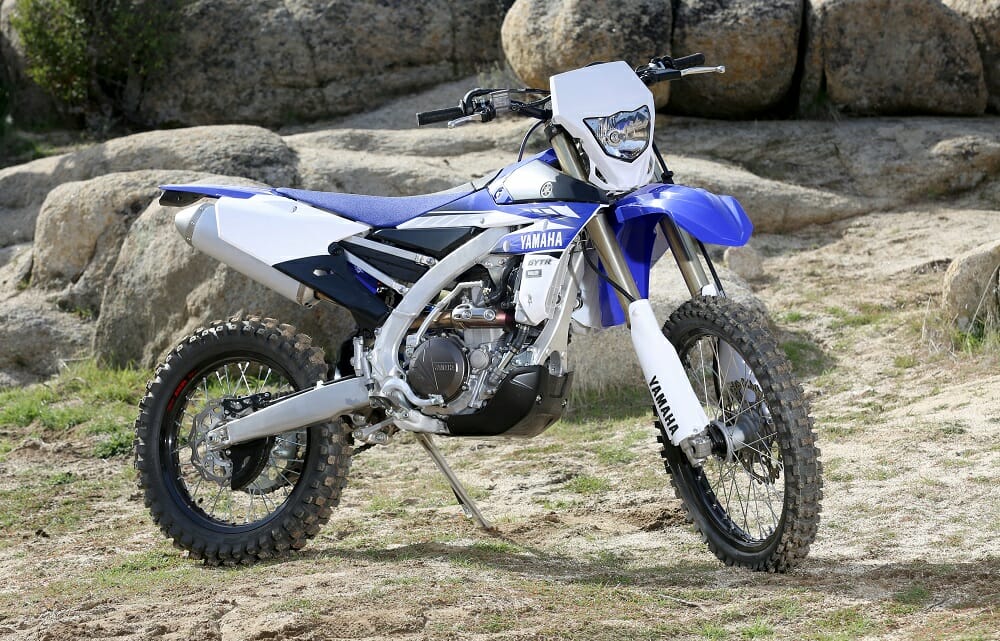 The Yamaha WR450F is high-tech and has racing in its DNA.
The Yamaha WR450F is high-tech and has racing in its DNA.
The Honda is old-school. It’s still carburetor and hasn’t changed much in the past 10 years but has a starred history when it comes to off-road racing, especially in Baja. The Honda is best known for being user-friendly on the trail and reliable. The EFI-equipped Suzuki is semi-new, first appearing in 2009 then quickly disappearing again a few weeks later due to emissions issues. It reappeared just this year in pretty much the same form as it did in 2009, but this time fully EPA compliant. The Yamaha, which got a major overhaul last year, is about as high-tech as it gets, featuring Yamaha’s “backwards” engine design and, of course, EFI. It’s closely resembles Yamaha’s latest YZ450F motocrosser.
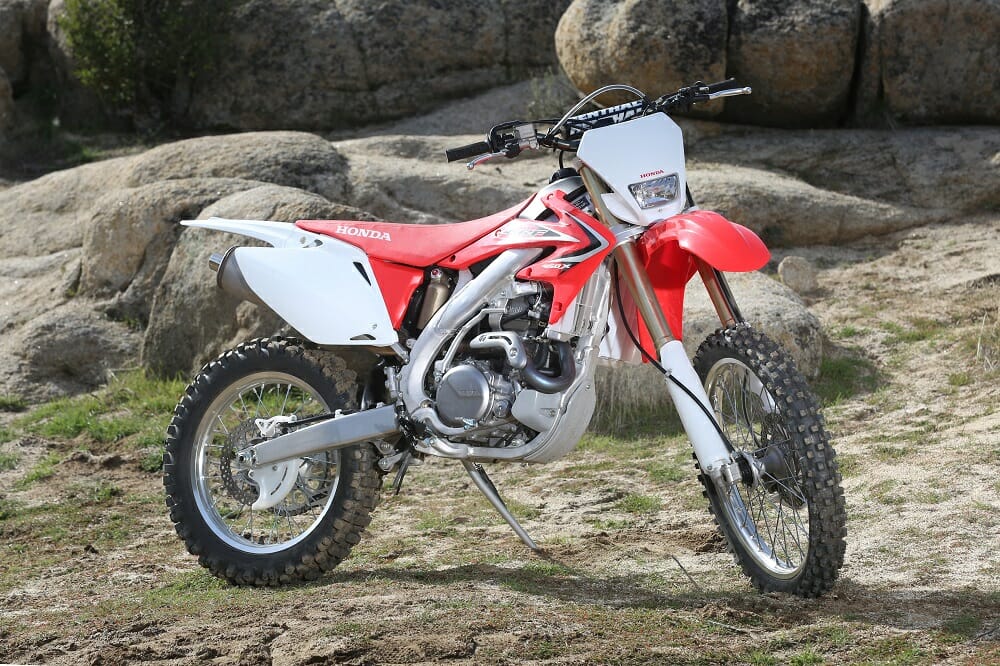 Even though the Honda CRF450X has been around a while, it’s still a fantastic well-round off-road bike.
Even though the Honda CRF450X has been around a while, it’s still a fantastic well-round off-road bike.
Ready To Ride
If you rolled the Honda, Yamaha and Suzuki off the showroom floor, all shiny, new and pretty, and headed straight your local public riding area and rode them in bone-stock form, the undisputed instant winner would be the carbureted Honda. How can a carbureted bike that hasn’t changed in over a decade be better than two modern fuel-injected bikes? Easy, Honda put a lot of work into meeting the Green Sticker regulations and making the bike run decent without using a throttle limiter that the Yamaha and Suzuki have. We aren’t saying the Honda CRF450X is perfectly jetted in stock form, it isn’t, but it is rideable. Both the Suzuki RMX450Z and the Yamaha WR450F use throttle stops (or limiters) to regulate how far the throttle body opens, drastically reducing horsepower and, of course, fun. The throttle stop, combined with a lean ECU setting and restricted airboxes, ensure that the RMX450Z and WR450R earn the right to run the Green Sticker.
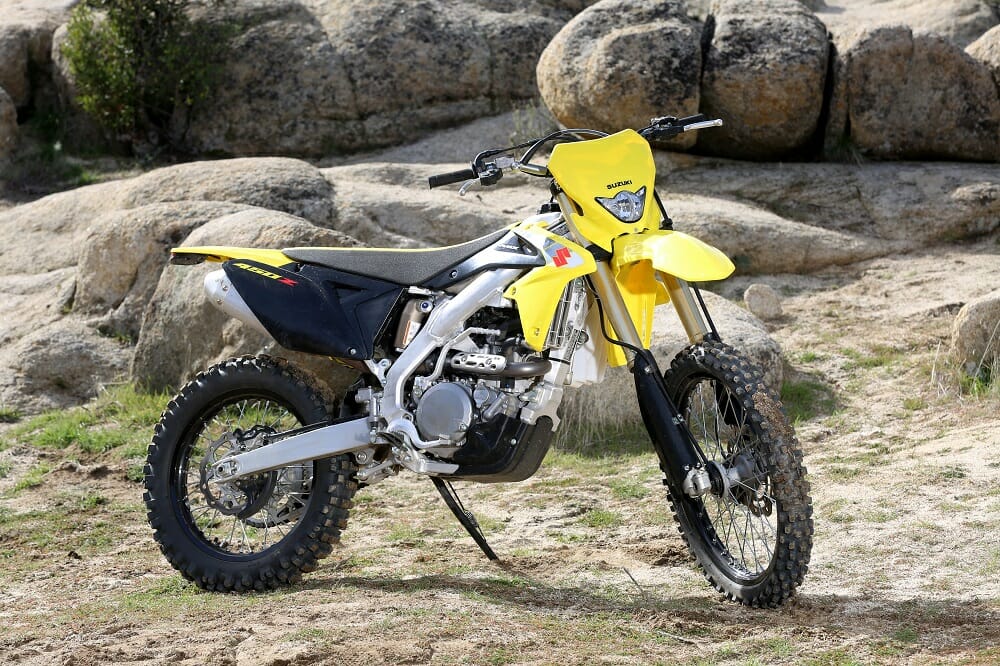 The Suzuki RMX returns with EFI.
The Suzuki RMX returns with EFI.
Because we test these bikes on private land (as well as during the winter months) we happily, and without guilt, removed the throttle stop on both the Suzuki and the Yamaha, but we left the airbox and exhaust systems in stock form, because the ECUs on both the RMX and WR are locked and can’t be adjusted, so modifying either or both of the airboxes or exhausts on the RMX and WR will actually hinder performance, not improve it. The Honda didn’t escape some fixing, too, as we took the liberty of changing out the ultra-lean needlejet in the carburetor for a slightly richer NCYS needle, with the clip positioned on the third groove from the top. (Keep in mind that, again, this seemingly harmless mod wipes away the X’s Green Sticker status. But you didn’t want to ride in the heat anyway, right?). Now we have three comparable motorcycles.
3rd Place
Suzuki RMX450Z
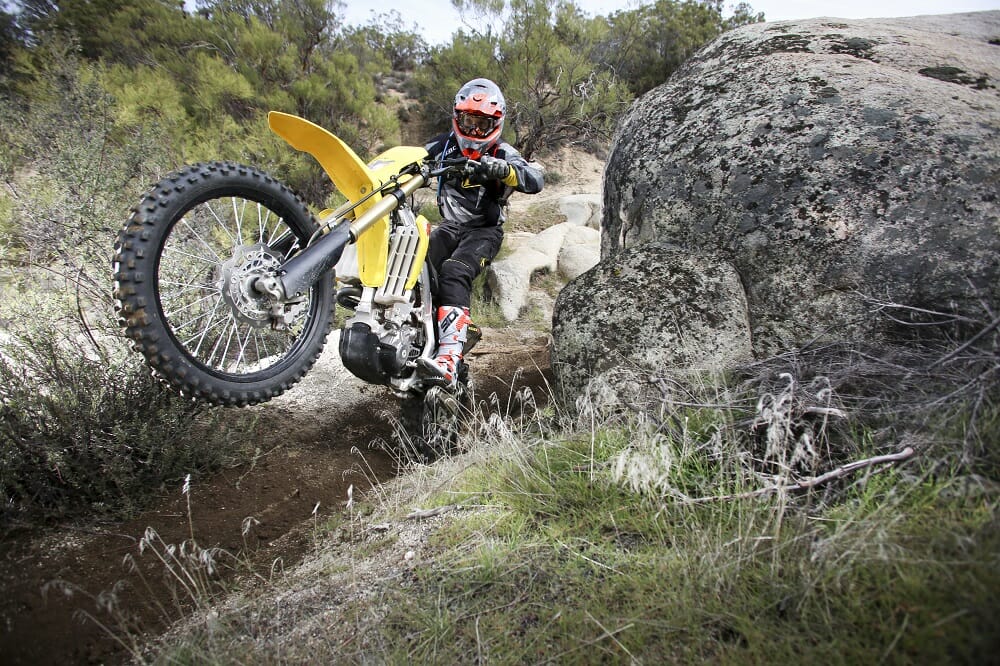 The RMX is hampered by ultra-lean mapping and a small gas tank but has tons of potential.
The RMX is hampered by ultra-lean mapping and a small gas tank but has tons of potential.
|
NOTABLE FEATURES
|
NOTABLE NUMBERS
|
|
Fuel-Injection
|
MSRP: $8999
|
|
Electronic Meter/Enduro Computer
|
Curb Weight: 273 lbs.
|
|
Electric Starting w/Kick Backup
|
Seat Height: 37.4 in.
|
|
Full Plastic Skid Plate
|
Ground Clearance: 12.8 in.
|
|
Fuel Capacity: 1.6 gal.
|
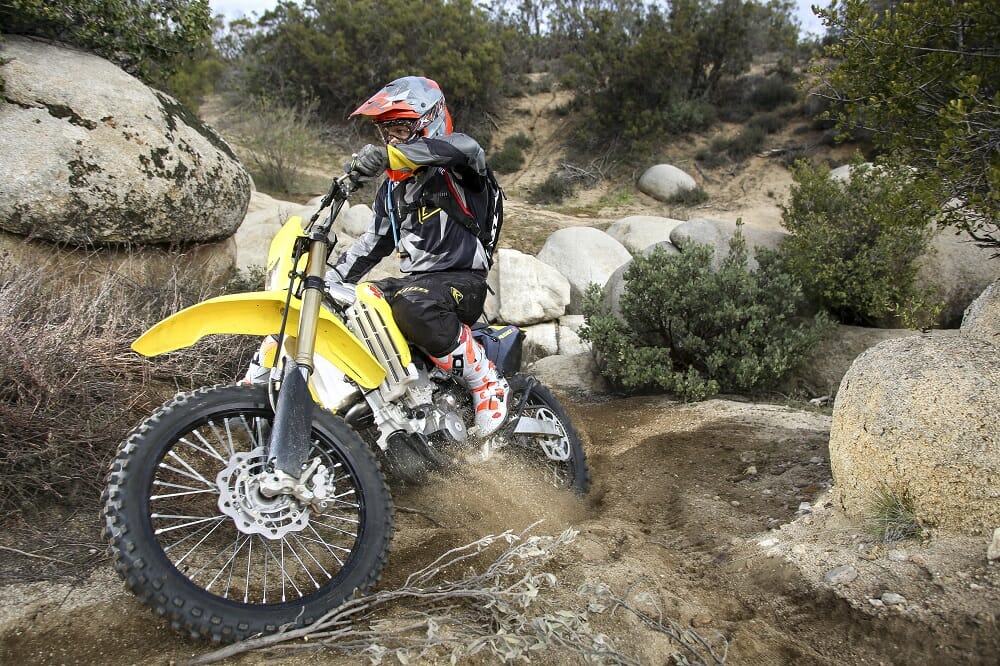 Like its MX cousin, the RMX turns like no other—in a good way!
Like its MX cousin, the RMX turns like no other—in a good way!
The 2017 RMX450Z is a trail bike built off the 2009 RM-Z450 motocross platform. For the RMX, its trail ability sits hidden beneath lean ECU tuning and a suspension that is set up for faster riding. The RMX works best in open spaces and at higher speeds where the suspension can move through the stroke and the engine isn’t being used right above idle in the pop-stall zone. In slower, more technical terrain the fork deflects and gives the rider a harsh ride.
The lean ECU settings cause terribly annoying engine-stalling issues at low speeds. We went through multiple clutch and front-brake levers after dropping the bike due to many untimely pop-stalls, i.e. flameouts. Unfortunately, since the ECU is tamper-proof, there is no easy fix. To compensate for the stalling, the bike must be ridden with a lot of clutch-work, but the clutch doesn’t hold up well to a lot of abuse. It’ll get hot and fade.
In stock form the 2017 RMX450Z isn’t nearly as trail-ready as the CRF450X and the WR450R. It is just too much like the 2009 RM-Z450 motocross machine to be considered a true off-road bike. The low-speed pop-stall and flame out issues at lower rpms isn’t at all conducive to true off-road riding and a clutch that fades under any abuse only contributes further to the stalling issues.
And then there is the gas tank. The RMX’s small 1.6-gallon gas tank, the same one that comes on the RM-Z450 motocross bike, is a major strike against it. It’s just not big enough for even moderately long rides. On average, after only 30 miles of riding, the low-fuel light lets you know you that you’re about to run out. You are down to fumes anywhere from 35-45 miles depending on ride style. No bueno.
But the Suzuki has plenty of strongpoints. Turning and handling are great. It turns just like its MX cousin (which is fantastic) and handling is precise. Ergos are comfortable, too. And when the engine isn’t cutting out at slow speeds, it’s actually well mannered, delivering lots of power in a super-smooth and very controllable manner.
Bottom line? The RMZ450X could very well have landed at the top of this list if not for its stalling issues that, again, has no easy fix. (A tiny gas tank and a weak clutch didn’t help its cause, either.)
GEAR ID’D
PANTS: Klim Mojave
JERSEY: Klim Dakar
HELMET: Klim F3
BOOTS: Sidi Crossfire 3 SR
2nd Place
HONDA CRF450X
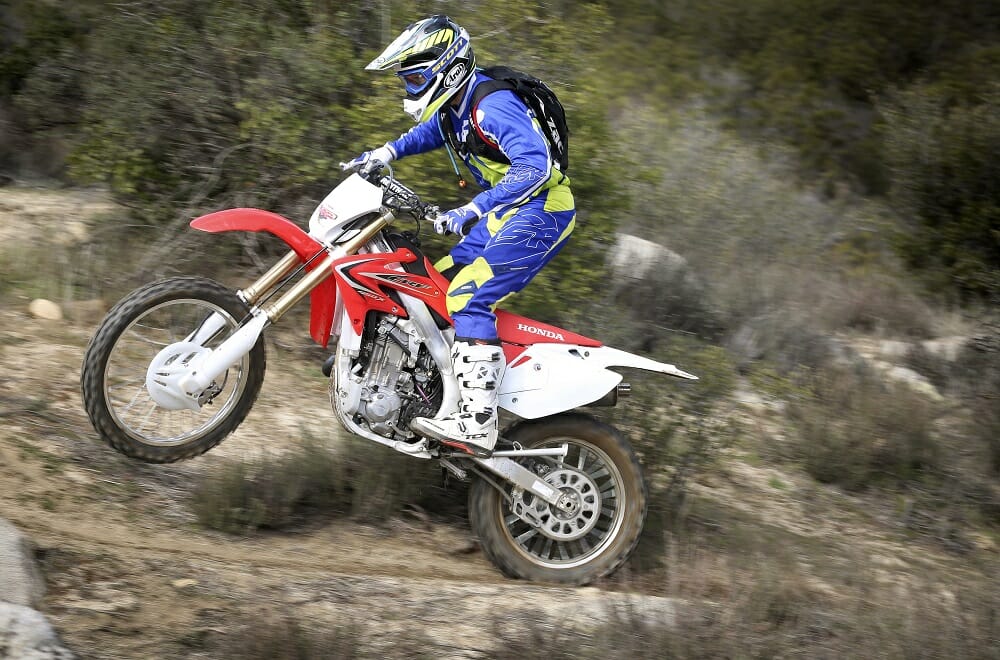 We’re still huge fans of the carbureted CRF450X.
We’re still huge fans of the carbureted CRF450X.
|
NOTABLE FEATURES
|
NOTABLE NUMBERS
|
|
Carbureted
|
MSRP: $8699
|
|
Unicam Valve Train
|
Curb Weight: 270 lbs.
|
|
Mechanical Meter
|
Seat Height: 37.9 in.
|
|
Electric Starting w/Kick Backup
|
Ground Clearance: 13. 6 in.
|
|
Honda Progressive Steering Damper
|
Fuel Capacity: 1.9 gal.
|
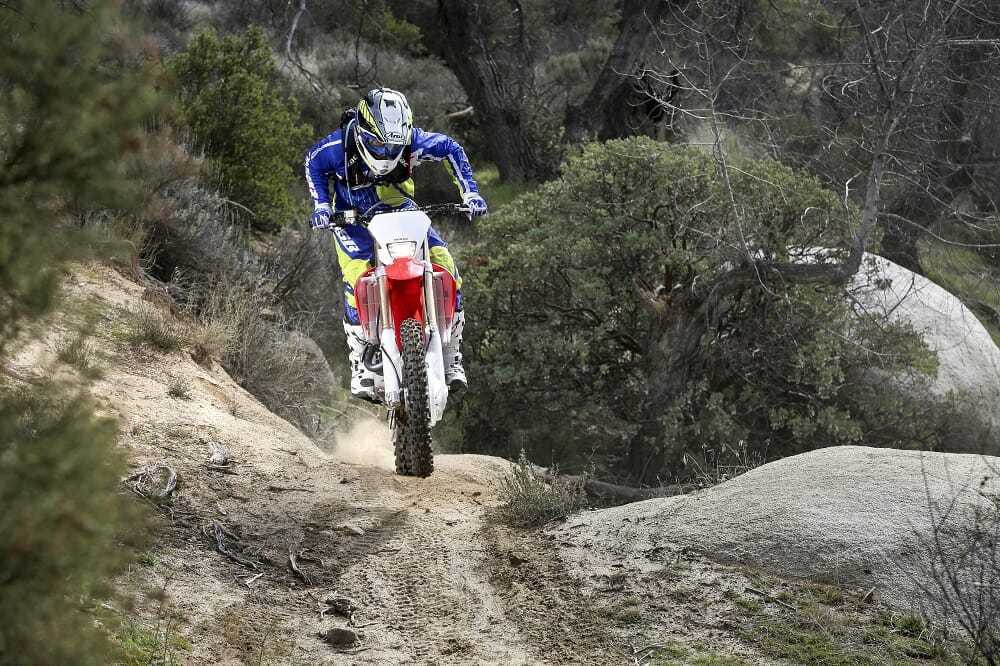 Off the three bikes, the Honda is the most user-friendly.
Off the three bikes, the Honda is the most user-friendly.
The Honda CRF450X is a wonderful, yet simple dirt bike. Yeah, some would call it antiquated, but as history has proven, it can win races and be enjoyed by trail riders of all skill levels. The Keihin carb is solid performer and can be jetted for higher altitudes if needed, but EFI does that automatically. Another downfall of a carb these days is that the pilot jet can clog if the bike is allowed to sit for more than a week, because of all the additives that’s put in gas these days. (The fuel—or what’s in the fuel—tends to crystalize, turning the tiny pilot jet passage into a solid plug. That’s why your bike runs like crap despite it running great the last time you rode it.) Still, carburetors have their advantages but it’s hard to beat EFI these days.
You have to kudos to Honda for meeting the Green Sticker jargen without going the throttle-stop route. The emissions equipment, particularly the air injection pump, however, causes a little pop on decel but nothing horrible.
The Honda CRF450X produces smooth power, and plenty of it. We still love how smoothly a carbureted 450cc four-stroke engine rolls-on off idle and the X is no exception. On tight trails riding, right above idle, the X’s engine is easy to control and is predictable and there is zero pop-stalling. When you want great power at any rpm, it is just a twist of the throttle away; it pulls strongly through the mid and into a healthy top end.
The stock Showa suspension is pretty good overall and works well for a variety of skill level and rider sizes. It can be left in stock trim and shine as a single-track machine, or it can be modified to handle high-speed racing situations (we know, we’ve done it in the past). The Honda is stable and predictable, great attributes for an off-road bike.
The Honda CRF450X is ideal for the rider who loves simplicity. There isn’t any EFI to mess with, just a good ol’ carburetor feeding a strong and proven engine. The CRF450X chassis is an awesome starting point for building a great off-road race machine, or even a dual-sport conversion for long explorations. There are a ton of suspension guys who can really improve the handling, and the choices for aftermarket goodies are endless.
The Yamaha and Suzuki have the Honda beat by a mile in the computer/display department. The Honda uses an old-style dial odometer, driven by a cable off the front wheel. Old-school, for sure.
In summary, the Honda CRF450X can wear a lot of hats depending on what is asked of it and do it relatively cheap. It’s still a great motorcycle and we’re thankful that Honda kept it in its off-road line despite the recent introduction of the Red Sticker CRF450X. They are two very different motorcycles that serve two entirely different needs (and well, we might add).
GEAR ID’D
GEARSET: MSR AXXIS
HYDRATION PACK: Zac Speed Exotec V2 Dakar
HELMET: Arai VX-Pro4
GOGGLES: Scott
BOOTS: TCX Comp
1st Place
Yamaha WR450F
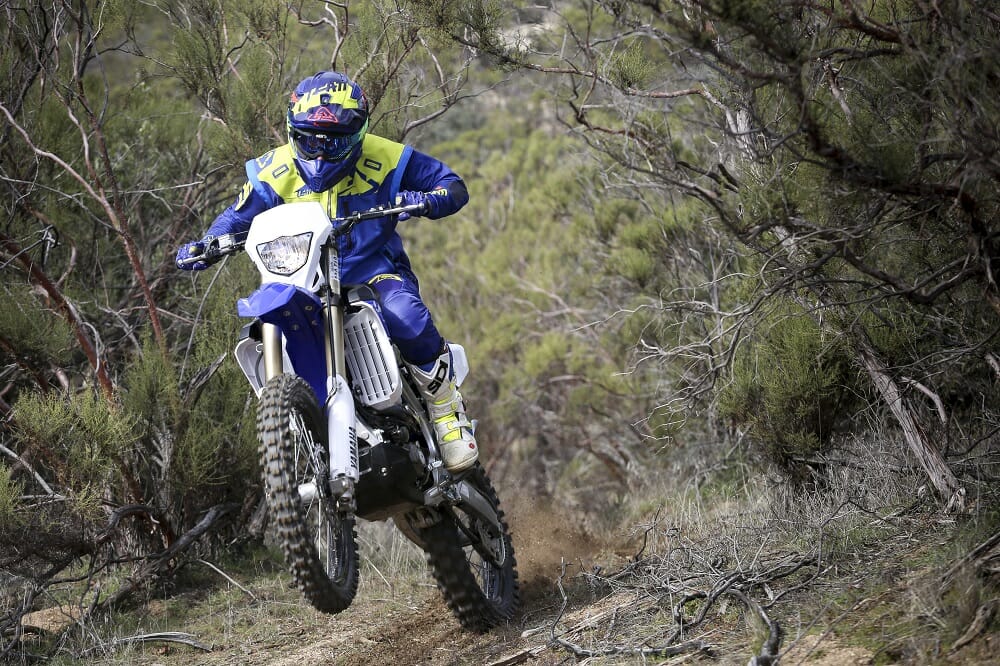 The Yamaha likes to be ridden aggressively.
The Yamaha likes to be ridden aggressively.
|
NOTABLE FEATURES
|
NOTABLE NUMBERS
|
|
Fuel-Injection
|
MSRP: $9099
|
|
Rearward-Slanted Engine
|
Curb Weight: 272 lbs.
|
|
Electronic Meter/Enduro Computer
|
Seat Height: 38.0 in.
|
|
Full Plastic Skid Plate
|
Ground Clearance: 12.8 in.
|
|
Starting System: Electric w/ kick backup
|
Fuel Capacity: 2.0 gal.
|
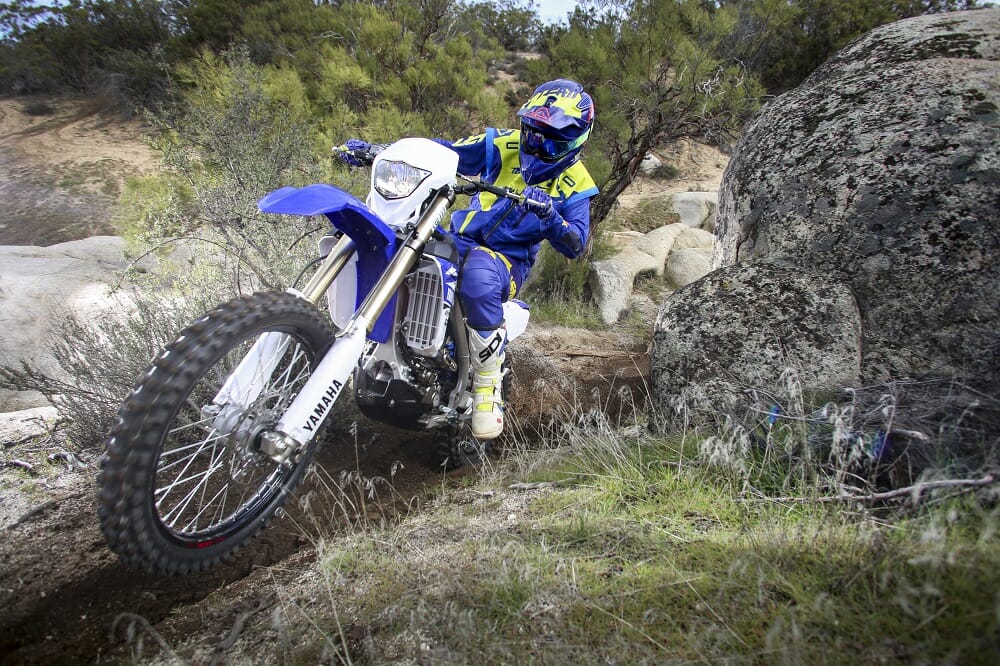 The WR can be a bit of a handful on ultra tight and technical trails (but all three can, too).
The WR can be a bit of a handful on ultra tight and technical trails (but all three can, too).
The 2017 Yamaha WR450R is essentially a slightly detuned version of the YZ450FX, Yamaha’s closed-course, Red Sticker, off-road race machine. It shares the same suspension spring rates (with different valving) and the same transmission ratios throughout the five-speed wide-ratio gearbox. The major differences come via the headlight, taillight, muffler and ECU settings. And as we’ve mentioned before, the WR450F comes stock with a throttle limiter. Without the throttle limiter, the Yamaha engine is potent, event with the stock ECU and muffler. It is very free revving with quick throttle response. It isn’t quite as snappy as the YZ450FX, but if you’re looking for an aggressive trail bike engine, here it is. It still can be ridden mellow and doesn’t flame out or pop-stall, making it very nice in technical terrain, but be warned, if you are reckless with the right hand, the responsive engine is happy to deliver tons of juice. The clutch is also very smooth and easy to modulate without much fading. This is the most aggressive and most powerful engine of the group by far.
The KYB suspension is the most modern of all three bikes and the action is plush with good bottoming resistance. Overall the Yamaha provides the most comfortable ride at any speed. The engine design and snappy response help lift the front wheel easily and gives the 272-pound machine a light feel most of the time. The weight becomes apparent when the speeds slow down and the trail gets ugly. The Yamaha doesn’t feel any heavier than the CRF450X or the RMX450Z, but they are all within a few pounds of each other.
The Yamaha is a bike that can do it all for a lot of riders, especially those who love a strong engine and great working EFI. The advantage the Yamaha has over the Honda is that no matter how well you jet a carb, EFI is so much better at really high altitudes, making the Yamaha WR450F more versatile. Also, in a world of technology, the CRF450X is the last of carbureted four-strokes.
In a nutshell, the Yamaha is a great all-around off-roader. It can be ridden aggressively or at a casual trail pace without a problem, and the Yamaha YZ and WR range has a reputation for outstanding reliability. For our testers, it came down to a two-way showdown between the Yamaha and Honda with the Yamaha getting the nod for its great-working EFI system and the ability to be ridden comfortably both aggressively and casually. Things, however, could’ve been a lot different had it not been for the RMX’s stalling issues. CN
GEAR ID’D
JERSEY: Leatt GPX 4.5 LITE
PANTS: Leatt GPX 5.5 I.K.S
JACKET: Leatt GPX X-Flow
GLOVES: Leatt GPX 5.5 Lite
HELMET: Leatt GPX 5.5 Composite V15
BOOTS: Sidi Crossfire
|
SPECIFICATIONS
|
2017 Honda CRF450X
|
2017 Suzuki RMX450Z
|
2017 Yamaha WR450R
|
|
MSRP:
|
$8,699
|
$8,999
|
$9,099
|
|
ENGINE:
|
Liquid-cooled Unicam 4-stroke, single
|
Liquid-cooled DOHC 4-stroke, single
|
Liquid-cooled DOHC 4-stroke single
|
|
DISPLACEMENT:
|
449cc
|
449cc
|
449cc
|
|
BORE X STROKE:
|
96.0 x 62.0mm
|
96.0 x 62.1mm
|
97.0mm x 60.8mm
|
|
COMPRESSION RATIO:
|
12.0:1
|
11.6:1
|
12.5:1
|
|
FUEL DELIVERY:
|
Carburetor
|
EFI Keihin 41mm
|
EFI Keihin 44mm
|
|
STARTING SYSTEM:
|
Electric/Kick
|
Electric/Kick
|
Electric/Kick
|
|
TRANSMISSION:
|
5-speed
|
5-speed
|
5-speed
|
|
FRAME:
|
Aluminum
|
Aluminum
|
Aluminum
|
|
FRONT SUSPENSION:
|
47mm Showa spring fork, fully-adj.
|
47mm Showa spring fork, fully-adj.
|
48mm KYB SSS spring fork, fully-adj.
|
|
REAR SUSPENSION:
|
Single shock, fully-adj.
|
Single shock, fully -adj.
|
Single shock, fully-adj.
|
|
FRONT WHEEL TRAVEL:
|
12.4 in.
|
12.2 in.
|
12.2 in.
|
|
REAR WHEEL TRAVEL:
|
12.3 in.
|
12.1 in.
|
12.5 in.
|
|
FRONT WHEEL:
|
80/100×21 in.
|
80/100×21 in.
|
80/100×21 in.
|
|
REAR WHEEL:
|
110/100×18 in.
|
120/100×18 in.
|
120/100×18 in.
|
|
FRONT BRAKE:
|
240mm Disc
|
260mm Disc
|
270mm Disc
|
|
REAR BRAKE:
|
240mm Disc
|
240mm Disc
|
245mm Disc
|
|
RAKE/TRAIL:
|
27°/4.3 in.
|
27.3°/4.4 in.
|
26.3°/4.5 in.
|
|
GROUND CLEARANCE:
|
13.6 in.
|
12.6 in.
|
12.8 in.
|
|
SEAT HEIGHT:
|
37.9 in.
|
37.4 in.
|
38.0 in.
|
|
WHEELBASE:
|
52.4 in.
|
58.5 in.
|
57.7 in.
|
|
FUEL CAPACITY:
|
1.9 gal.
|
1.6 gal.
|
2.0 gal.
|
|
CURB WEIGHT (actual):
|
270 lbs.
|
273 lbs.
|
272 lbs.
|